Ergonomics, which refers to studying people in their working environment to reduce the risk of discomfort or injury, is very important for all, especially for employees with physically demanding jobs. Healthcare workers who are almost always on their feet to lift, transfer, and reposition patients must understand the basics of ergonomics principles to keep themselves comfortable, safe, and injury-free.
Unfortunately, even though healthcare workers know how proper ergonomics works, it’s not always practiced. In a 2025 study, researchers found that 99.3% of the nurse respondents shared that they were familiar with the concept of ergonomics. However, only 26% of the participants possessed high levels of ergonomics knowledge, had positive attitudes toward it, and demonstrated good ergonomics practices.
This article discusses the negative effects of poor ergonomics in the workplace. It also provides helpful guidance for healthcare employees on improving ergonomics and safety at work.
What are the effects of poor ergonomics?
Healthcare professionals frequently lift heavy objects and people, push and pull heavy devices, and perform a series of motions for an extended period that can contribute to the development of ergonomic injuries. Poor ergonomics can lead to different injuries, such as:
· Cumulative trauma disorders (CTDs): May have different causes, including doing repetitive tasks, forceful exertions, and even sustained or awkward positions.
· Repetitive strain injuries (RSIs): These injuries occur when repetitive motions result in damage to the muscles, tendons, or nerves.
· Musculoskeletal disorders (MSDs): These injuries affect the muscles, bones, joints, and connective tissues.
What can healthcare professionals do to improve ergonomics and safety in the workplace?
Understand and adopt proper lifting techniques
Lifting, repositioning, and transferring patients come with the territory, and healthcare workers need to understand and practice proper lifting techniques to ensure that injuries are avoided or reduced.
Proper lifting techniques include:
· Make sure your feet are shoulder-width apart, with one foot slightly ahead of the other.
· Squat and bend at the hips and knees.
· Keep your back straight, chest out, shoulders back, and look straight ahead.
· Slowly lift and don’t twist as you lift. Keep your hips and knees straight, too.
· Take small steps. Use your hips to change directions while keeping your shoulders in line with your hips.
· Carefully set down your load while squatting using your knees and hips, not your back.
Use assistive devices
Assistive devices such as lifts, hoists, transfer belts, and sliding boards can help healthcare workers lift loads properly, efficiently, and safely.
The following are important things to keep in mind when using assistive devices:
· Make sure you’re properly trained and authorized to use assistive devices before using them.
· Check the devices and ensure they’re clean and in proper working condition.
· Assess if the device to be used is appropriate for the patient. Consider the patient’s weight, condition, and the type of move the patient requires.
Mind your posture when using the computer
Healthcare professionals spend a lot of time on the computer for documentation and charting tasks — specifically, in the US, about 25% to 41% of nurses’ time — so it’s crucial to apply proper ergonomics when using the computer at work.
The following are helpful ergonomics tips when using the computer:
· Your keyboard and mouse should be placed in a way that reduces the strain on your fingers, wrists, arms, and shoulders.
· Lightly hold the mouse. Avoid gripping or squeezing it. It should be positioned close to the keyboard so that you won’t need to strain or stretch your hand when you reach for it.
· Position your monitor slightly below eye level, straight ahead, and about arm’s length away from your face.
· Ensure that your chair supports your back in an upright and relaxed arched position.
We hope that these tips can help you maintain proper ergonomics at work. By adhering to these ergonomic principles and ensuring the proper use of assistive devices, healthcare professionals can significantly reduce the risk of strain and injury. A well-maintained and thoughtfully arranged workspace not only enhances comfort but also boosts productivity and the overall quality of patient care.







